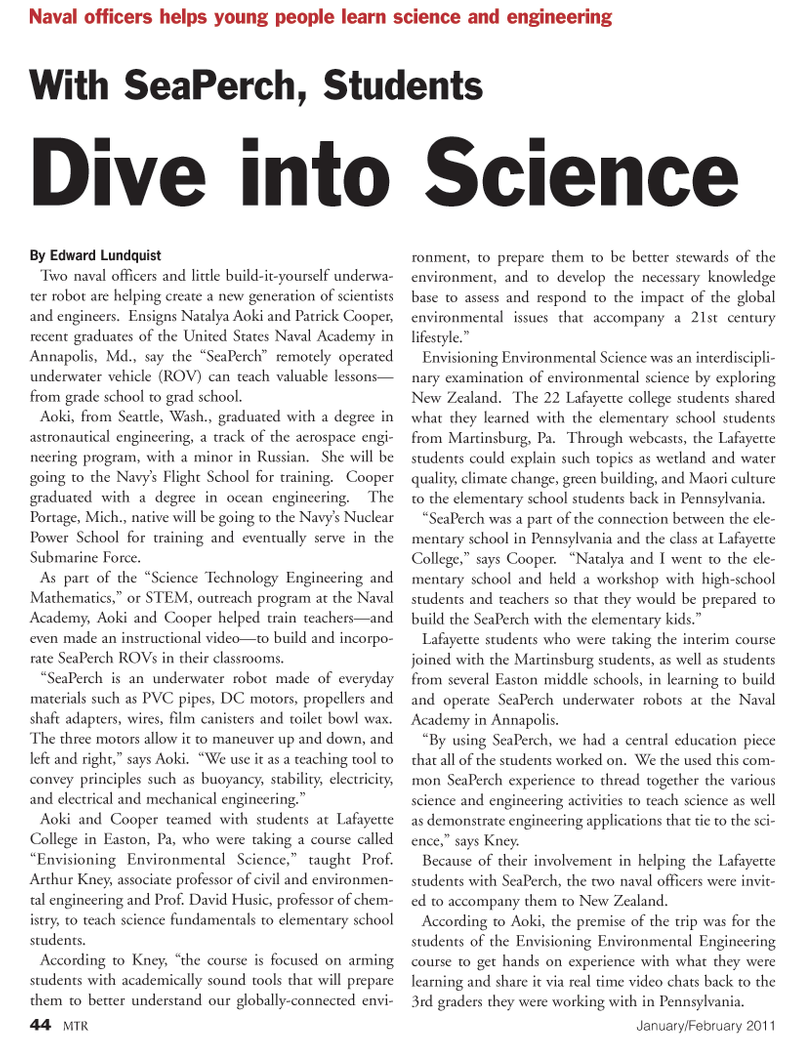
Page 44: of Marine Technology Magazine (January 2011)
Marine Salvage & Recovery
Read this page in Pdf, Flash or Html5 edition of January 2011 Marine Technology Magazine
44 MTR January/February 2011
By Edward Lundquist
Two naval officers and little build-it-yourself underwa- ter robot are helping create a new generation of scientists and engineers. Ensigns Natalya Aoki and Patrick Cooper, recent graduates of the United States Naval Academy in
Annapolis, Md., say the “SeaPerch” remotely operated underwater vehicle (ROV) can teach valuable lessons— from grade school to grad school.
Aoki, from Seattle, Wash., graduated with a degree in astronautical engineering, a track of the aerospace engi- neering program, with a minor in Russian. She will be going to the Navy’s Flight School for training. Cooper graduated with a degree in ocean engineering. The
Portage, Mich., native will be going to the Navy’s Nuclear
Power School for training and eventually serve in the
Submarine Force.
As part of the “Science Technology Engineering and
Mathematics,” or STEM, outreach program at the Naval
Academy, Aoki and Cooper helped train teachers—and even made an instructional video—to build and incorpo- rate SeaPerch ROVs in their classrooms. “SeaPerch is an underwater robot made of everyday materials such as PVC pipes, DC motors, propellers and shaft adapters, wires, film canisters and toilet bowl wax.
The three motors allow it to maneuver up and down, and left and right,” says Aoki. “We use it as a teaching tool to convey principles such as buoyancy, stability, electricity, and electrical and mechanical engineering.”
Aoki and Cooper teamed with students at Lafayette
College in Easton, Pa, who were taking a course called “Envisioning Environmental Science,” taught Prof.
Arthur Kney, associate professor of civil and environmen- tal engineering and Prof. David Husic, professor of chem- istry, to teach science fundamentals to elementary school students.
According to Kney, “the course is focused on arming students with academically sound tools that will prepare them to better understand our globally-connected envi- ronment, to prepare them to be better stewards of the environment, and to develop the necessary knowledge base to assess and respond to the impact of the global environmental issues that accompany a 21st century lifestyle.”
Envisioning Environmental Science was an interdiscipli- nary examination of environmental science by exploring
New Zealand. The 22 Lafayette college students shared what they learned with the elementary school students from Martinsburg, Pa. Through webcasts, the Lafayette students could explain such topics as wetland and water quality, climate change, green building, and Maori culture to the elementary school students back in Pennsylvania. “SeaPerch was a part of the connection between the ele- mentary school in Pennsylvania and the class at Lafayette
College,” says Cooper. “Natalya and I went to the ele- mentary school and held a workshop with high-school students and teachers so that they would be prepared to build the SeaPerch with the elementary kids.”
Lafayette students who were taking the interim course joined with the Martinsburg students, as well as students from several Easton middle schools, in learning to build and operate SeaPerch underwater robots at the Naval
Academy in Annapolis. “By using SeaPerch, we had a central education piece that all of the students worked on. We the used this com- mon SeaPerch experience to thread together the various science and engineering activities to teach science as well as demonstrate engineering applications that tie to the sci- ence,” says Kney.
Because of their involvement in helping the Lafayette students with SeaPerch, the two naval officers were invit- ed to accompany them to New Zealand.
According to Aoki, the premise of the trip was for the students of the Envisioning Environmental Engineering course to get hands on experience with what they were learning and share it via real time video chats back to the 3rd graders they were working with in Pennsylvania.
Naval officers helps young people learn science and engineering
With SeaPerch, Students
Dive into Science

 43
43

 45
45
